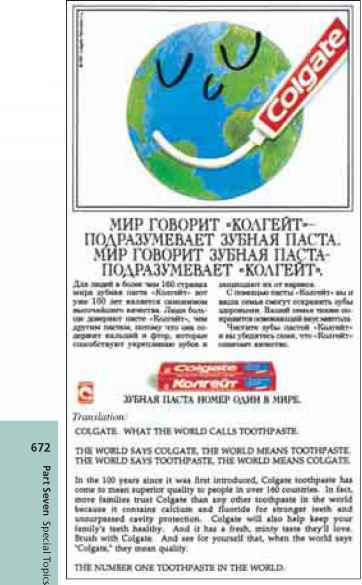Problems with Global Advertising
Opponents of the standardized global approach argue that very few products lend themselves to global advertising.57 Differences in culture, market, and economic development; consumer needs and usage patterns; media availabilities; and legal restrictions make it extremely difficult to develop an effective universal approach to marketing and advertising. Advertising may be particularly difficult to standardize because of cultural differences in circumstances, language, traditions, values, beliefs, lifestyle, music, and so on. Moreover, some experts argue that cultures around the world are becoming more diverse, not less so. Thus, advertising's job of informing and persuading consumers and moving them toward using a particular brand can be done only within a given culture.
Consumer usage patterns and perceptions of a product may vary from one country to another, so advertisers must adjust their marketing and advertising approaches to different problems they may face in different markets. For example, when Nestlé introduced its Nescafé instant coffee brand, the company faced at least five different situations in various parts of the world:
1. In the United States, the idea of instant coffee had great penetration but Nescafé had the minor share.
2. In continental Europe, Nescafé had the major share of the market, but the idea of instant coffee was in the early stages.
3. In the tea-drinking countries, such as the United Kingdom and Japan, tea drinkers had to be converted not just to coffee but to instant coffee.
4. In Latin America, the preferred coffee was a heavy one that could not be duplicated with an instant version.
5. In Scandinavia, Nestlé had to deal with the ingrained custom of keeping a pot of coffee on the stove from early morning until late at night.
Nestlé had to use different advertising strategies for each market; a global campaign would not have been able to address the varying situations adequately. Exhibit
Exhibit 20-7 A. Nescafe instant coffee ad used in Japan B. Nescafe instant coffee ad used in Norway
Exhibit 20-7 A. Nescafe instant coffee ad used in Japan B. Nescafe instant coffee ad used in Norway

20-7 shows Nescafé ads used in Japan and Norway. Nestlé encountered yet another challenge when it entered the Israeli market in 1995. Nescafé was the generic word for instant coffee as Israelis assumed that it was an abbreviation of the Hebrew word namess (dissolving). Israeli consumers were also not very demanding with respect to the quality of their coffee and considered the low-quality powdered coffee, or nescafé, produced by a local company, suitable fare. To overcome the generic connotation of Nescafé, all of the advertising presented the Nescafé Classic brand as "Nescafé of Nestlé" and portrayed it as the coffee choice of people all around the world (Exhibit 20-8). The company also relied on taste testing at the points of sale so consumers could experience Nescafé Classic's superior quality. Within one year Nestlé had 30 percent of the instant coffee market in Israel.58
Many experts believe that marketing a standardized product the same way all over the world can turn off consumers, alienate employees, and blind a company to diversities in customer needs. For example, when McDonald's expanded to Puerto Rico, it alienated consumers by using American TV ads dubbed in Spanish and then using Hispanic ads that were brought in from New York, which subsequent research showed looked too Mexican.59
Parker Pen also encountered problems when it attempted to use global advertising in the mid-1980s. Local managers in its foreign branches resented the home office centralizing the advertising function with one worldwide agency and mandating the type of advertising appeal used in their markets.60
Such problems have led some major companies to move away from a completely standardized approach. For example, the Colgate-Palmolive Co. has used global advertising for many of its brands, including the Colgate, Palmolive, Fab, and Ajax product
Exhibit 20-8 Nestlé had to reshape Israel's definition of instant coffee


- Exhibit 20-9 Advertising for Colgate toothpaste uses a consistent visual image, but the copy may vary for different markets
lines, and continues to endorse the use of global appeals. Under its current marketing strategy, however, advertising is often modified for a specific country or region, particularly where local creativity can improve the advertising over the global standard. An example of this approach is the advertising used for Colgate toothpaste (see Exhibit 20-9). The globe/smile image is used as the visual in nearly every country where Colgate is marketed, but the copy varies. This ad for the Russian market appeared in the Moscow edition of Reader's Digest.
Some marketing experts claim much of the attention to the advantages of global advertising stems from large ad agencies trying to increase business by encouraging clients to use one agency to handle their marketing communications worldwide.61 Many large multinational companies are indeed consolidating their business with one or a few agencies who have offices around the world and offer international advertising capabilities. However, the consolidations are often driven by the client's increasing emphasis on global markets.62
Continue reading here: When Is Globalization Appropriate
Was this article helpful?
Readers' Questions
-
Phyllis1 year ago
- Reply
-
jimmy1 year ago
- Reply
-
elen1 year ago
- Reply
-
demi1 year ago
- Reply
-
frediana1 year ago
- Reply
-
Hobson Puddifoot1 year ago
- Reply
-
shaun1 year ago
- Reply